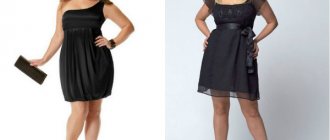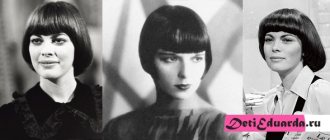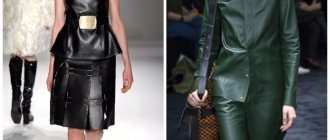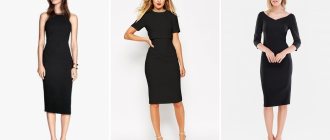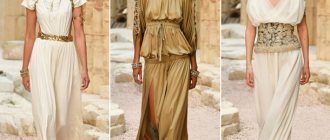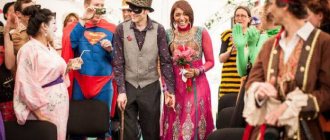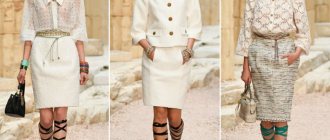Fashionable styles
“Fashion changes, but style remains. I want to be copied, this will be the best proof of my success,” said the great Coco. The classic little black dress is still popular today, but it is being replaced by more modern models, featuring a variety of cuts, styles and even decor.
The hem no longer has to cover the knees. The actual length should be selected based on the individual characteristics of the figure. A black mini or slit outfit, like Prabal Gurung, Ralph Lauren, Versace, looks impressive.
Maxi or mid-calf models will create a sexy but modest look. Similar dresses can be seen in the collections of Chanel, DKNY, Calvin Klein, BOSS, Jil Sander.
Sheath dress
You can find trendy identical dresses for mother and daughter here.
Details
The semicircular neckline has been replaced by:
- Necklines vary in depth, as seen on floaty midi dresses with full skirts from Calvin Klein, luxurious draped models from Miu Miu and revealing chiffon minidresses from Mulberry.
- A wide boat neckline, like the skinny knit dresses from Dorothy Perkins or the flowy ones from D&G.
- Collars – stand-up, golf, shirt. Dresses with a collar are found in the collections of Jason Wu, Isabel Marent, Christian Dior.
Long sleeves of all kinds, from narrow to flared, with draperies or lace can be seen in the collections of Jil Sander, Fornarina, Blumarine, Kenzo, Jason Wu.
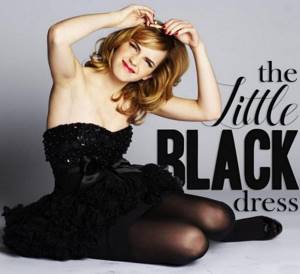
Fashionable interpretation
Mid-length sleeves are present on short black Escada Sport dresses, feminine below-the-knee styles from Dolce & Gabbana. Short sleeves are found in models of Versace Jeans dresses, with belts decorated with spectacular buckles, Prabal Gurung with a revealing slit, made of leather from Tommy Hilfiger.
Sexy, feminine outfits with wide and narrow straps from D&G, Jil Sander, Valentino, Paco Rabanne will become the basis of a passionate but fragile look.
Evening bandeau dresses are the choice of fatal seductresses (Oscar de la Renta, Miu Miu, Jason Wu).
You will find inexpensive variations of the legendary outfit in the Love Republic dress collections.
Decor
Modern little black dresses are no longer so demanding on the lack of decor; more and more often you can find models:
- With lace inserts, like BCBGMAXAZRIA. Dolce & Gabbana presented elegant black lace outfits that slightly covered the knees, while Alexis Mabille offered an extravagant outfit with a mesh insert in the neckline. A lace skirt and a satin fitted bodice - this combination from Oscar de la Renta will emphasize graceful legs and a slender waist.
- Embroidery or rhinestones, like Alberta Feretti and D&G.
- Contrast trim on the collar, cuffs or hem, as in flared models from Derek Lam.
- Ruffles and pleating complement models from Chanel, Fendi, Emmanuel Ungaro. Their collections also include wonderful dresses with flounces on the shoulders.
- The outfits of Jason Wu and Michael Cors were decorated with feathers.
- Some models are decorated with wide leather belts with or without spectacular buckles (Versace, Saint Laurent, Isabel Marant).
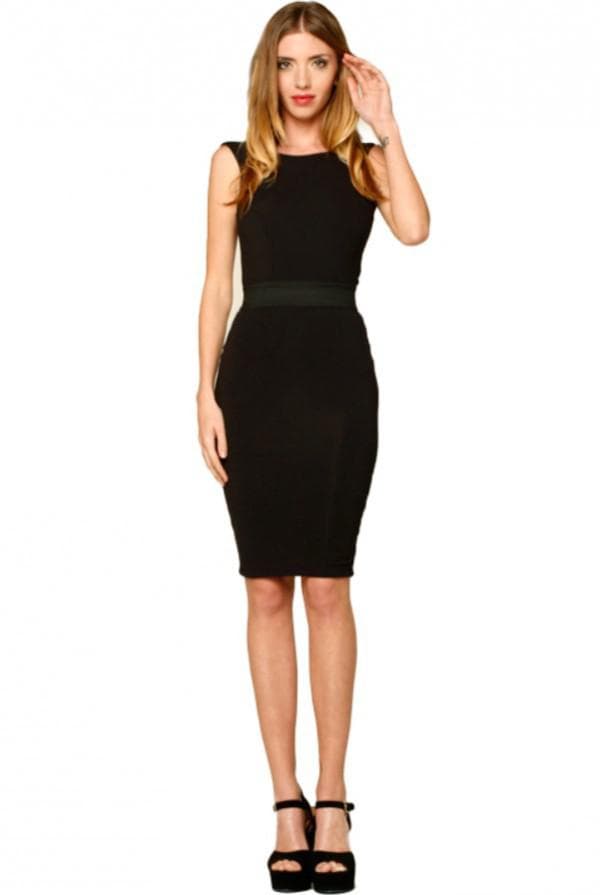
Minimum decor
Mature ladies will like the models proposed in the article about dresses for women over 40 years old.
Silhouettes
The styles are also not limited to a tight-fitting silhouette. Little black dresses today are easy to choose according to your figure:
- Tunics made of velvet (Marc Jacobs), lace (No. 21), knitwear (Iceberg).
- A-line (Mulberry, Alexander Wang, Valentino).
- Long outfits with a tight silhouette were presented by Blumarine and Jil Sander.
- Sheath dresses just below the knee (Paul Smith) and mini (Mugler), with fur trim (Givenchy).
- Asymmetrical cut (DKNY, Barbara Bui).
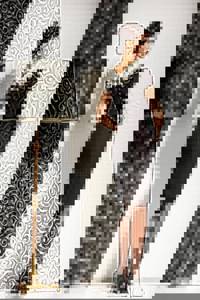
Model with collar
Fashion revolution after the war
The dress quickly became popular. Of course, his banner was the name Coco Chanel. But almost on par with him was his revolutionary spirit, when a woman had to look elegant and practical every day.
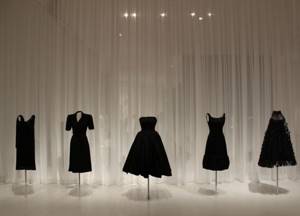
As the Frenchwoman herself noted, “fashion is equal to the time in which it lives and fashion cannot be divorced from reality. But she still has to give a dream.”
According to Chanel, this balance should become the main thing in the plans and aspirations of designers. Despite the gloominess of the color, Chanel herself did not consider it such and soon proclaimed it the color of freedom and strength. And what Chanel said was repeated by the whole world.
Selection of accessories
Accessories can completely change the look of a black dress, making it either modest and casual or dressy and luxurious. “First sew the dress, and then choose the trim,” Gabrielle Chanel advised. It is the accessories that add personality to a little black outfit, making it special and unique.
The Little Black dress was originally created as a universal model that would go with anything. It is this feature that makes this item basic in the wardrobe.
This article will help you create a trendy dress from scrap materials in 30 minutes.
Decorations
Chanel herself was very fond of jewelry, always wore a lot of it (but no more than seven at a time) and strongly recommended it to all women, and they had to choose from high-quality costume jewelry, and the jewelry should be stored in a safe.
For costume jewelry, golden or silver-colored jewelry, both laconic and fancy in shape, is suitable:
- The short-sleeved outfit will be complemented by massive bracelets and rings.
- For models with a neckline, choose voluminous necklaces or necklaces, and a closed neckline will be complemented by 1-3 strands of pearls.
Choose a set of medium-sized jewelry for your dress - beads, earrings and a bracelet. The larger the jewelry, the smaller it should be, so it’s quite possible to limit yourself to one massive bracelet or earrings.
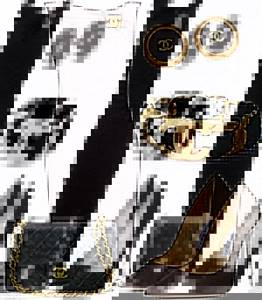
Accessories
Handbag
The perfect addition to a Chanel-style look is a small quilted handbag on a chain, designed by Coco Chanel to complement the image of an independent and confident woman.
Among the bags, you should choose models with a chain or strap to keep your hands free. The accessory itself can be made of smooth or patent leather, suede, its color should be in harmony with shoes or jewelry.
Shoes
The perfect complement to an elegant look with a little black dress is classic mid-heeled pumps. For the evening, high-heeled shoes are suitable, and for everyday use, ballet flats or shoes with stable low heels or platforms.
Coco recommended wearing her dress with two-tone shoes, which she also designed. Such shoes looked elegant, visually reduced the size of the foot, but at the same time, for a long time they were considered too shocking.
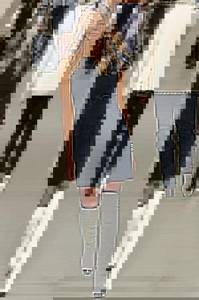
Autumn chic
Hats
Chanel introduced small hats into fashion, reminiscent of the sailor hats of that time. The elegant hat has replaced the massive compositions decorated with feathers, which for a long time crowned the heads of society ladies.
It's fashionable to decorate your outfit with an elegant wide-brimmed felt hat, a straw boater, or create a gangster look with a fedora.
Another option to complement the look is to tie a stylish belt or bow. Find out how to tie a belt on a dress here.
Perfume
A must-have accessory, without which the image will be incomplete – a high-quality and correctly selected perfume. Perfume notifies that a woman has arrived and reminds her after leaving. In the morning you can apply a light, fresh scent, and in the evening replace it with a deeper and more sensual one.
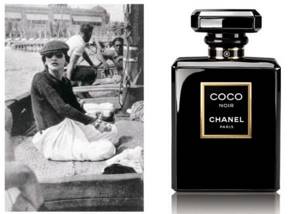
Perfume
This article will help you choose a large size dress for the New Year.
Finding the perfect little black dress is not difficult, but it is best to have 2-3 models of different lengths and styles in your wardrobe. In this case, the question “What to wear?” will disappear by itself, just choose the right accessories for each occasion. And don’t forget about makeup and hairstyle, which are an integral part of a woman’s image.
Little Black Dress – from Chanel to Givenchy
As you know, Coco Chanel was a fan of neutral colors, which gave her great pleasure. While in mourning after the death of her lover in 1915, her passion for the color black was expressed in the design of the Little Black Dress.
The famous question Paul Poiret asked Coco Chanel:
-Who are you mourning for, mademoiselle?
Chanel replied:
- About you, monsignor!
The legendary march of the Little Black Dress began with a publication in Vogue in 1926—October 1, to be precise. It was simple, calf-length, with straight lines. It was because of this simple style that Vogue called it “Chanel's Ford Dress” in honor of the very first mass-produced Ford T, which was simple and... always black.
Its flattering silhouette suited all body types, and its understated design epitomized the “Parisian understatement” that quickly replaced the exotic and garish outfits championed by Paul Poiret.
However, among the wealthy US women who were Vogue's main audience in the late 1920s, Chanel's casual dresses were not very popular. At that time, they were leafing through the magazine in search of hot new products from Jeanne Paquin, Madeline Voinnet and Jacques Doucet.
Little Black “Casual Dress” by Coco Chanel – 1920s.
It was a small publication in Vogue magazine for October 1926.
The exact description looked like this:
The “Ford Dress” from Chanel is a “monastic robe” that the whole world will wear. We're talking about the 817 in black crepe de Chine.
This is how simple the description looked. No fanfare. No enthusiastic cries about a “breakthrough in the fashion world.” But the most important message was the phrase that “the whole world will wear this cassock.”
By and large, the general style of the Little Black Dress originates from the so-called “flapper style”. In fact, there is no adequate translation of the term “flapper style” in Russian. It originated in the early 1920s and represented women's finally gained freedom from having to wear pompous and uncomfortable outfits. Probably the most correct equivalent would be “simple outfit” :).
So, returning to the “flapper style”, some still have doubts about who really invented the Little Black Dress. Although, Coco Chanel's contribution to the popularization of this style is decisive.
Little black dress - photo from the 1930s.
With the advent of the 1930s, other designers, notably Nettie Rosenstein and Elsa Schiaparelli, began to create their own Little Black Dress designs. At this time, this style became the basis of a simple evening dress.
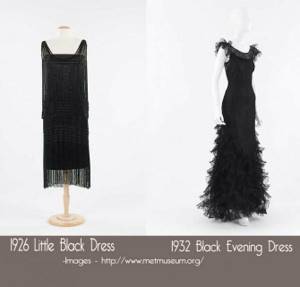
Hollywood also helped strengthen the position of the little black dress, thanks to the cartoon character Betty Boop. Although her “playful dress” was originally well above the knee, the conservative look of the 1930s “dropped” the length of her dress to “just below the knee.” And the “boyish” style of the cartoon heroine, so popular in the 1920s, was changed to more neutral feminine lines.
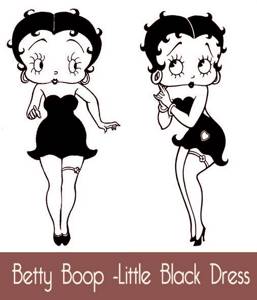
Little Black Dress in the 1940s and 50s.
The tense situation with fabric in the 1940s led many to believe that the Little Black Dress was the epitome of stylish minimalism. The fact that it goes well with various accessories began to give the dress additional popularity.
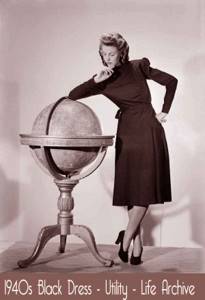
The simple and elegant silhouette and black color make it the perfect base for several ready-to-wear looks. Many women of that time could not afford to have many elegant outfits, each of which would suit a specific occasion. This photo from Life clearly shows a woman's casual outfit, which can easily be transformed into an evening look thanks to the elegant addition of a hat. It was after World War II that many lovers of magnificent dresses acquired the Little Black Dress to match the fashion of that time.
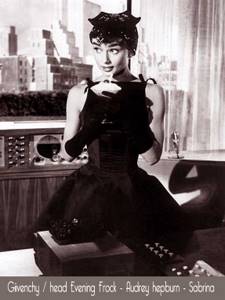
Designed by Edith Head and inspired by Givenchy, the full-skirted evening dress with a bust-hugging “top” that looked great on Audrey Hepburn in Sabrina epitomized the post-war glamor of the Little Black Dress. Despite some changes that came from Dior's style, the creator of the dress, Coco Chanel, finally established that “MChP” is an ideal element of a woman’s wardrobe, the elegance of which will not be subject to time.
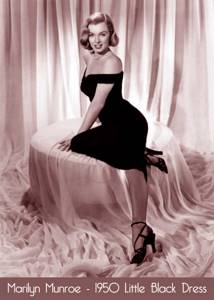
Little Black Dress - 1960s.
At this time, the color black came into full control... and with it, naturally, the Little Black Dress.
In the film Breakfast at Tiffany's, Audrey Hepburn appears in the famous black dress by Hubert de Givenchy. Just in the 1960s, the revival of 1920s fashion with its short haircuts, short skirts and boyish looks begins. Pop stars like Jane Birkin took PIL to new heights. At the 1964 Eurovision Song Contest, it was the Little Black Dress that captivated the audience, complementing the elegant look of Anneke Grönloh, who was one of the participants.
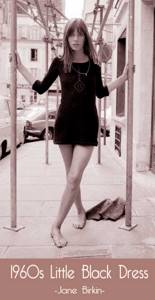
In the 60s, the popularity of MChP reached its apogee, which secured its strong place in the wardrobe of any woman who values simplicity and elegance.
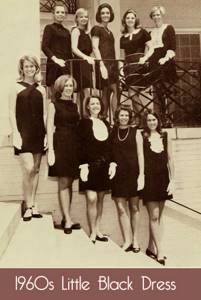
The material in this post was found on the Internet: https://glamourdaze.com/2012/08/the-little-black-dress-from-chanel-to-givenchy.html.
Crowned black
This color (or rather “non-color”) was in fashion many times before Chanel. At the beginning of the 16th century, the Dukes of Milan and Venetian merchants, who loved to show off their wealth, became interested in it. Thanks to a clever new processing method, black-dyed fabrics did not fade, were much more expensive than before, and became very popular among wealthy merchants and fashionable aristocrats. It was the Italians who were the first to combine black with black, playing on the difference in textures. The young man in Bronzino's portrait is clearly proud of his black silk jubba (jacket), the velvet lining visible through the slits. Isn't this the first version of "little black"?
In the 17th century, Dutch burghers fell in love with this color. And at the beginning of the 19th century, pale-faced romantics plunged into the loose waves of black velvet. In the middle of the century, the French Empress Eugenie (Spanish by birth) introduced black into everyday fashion. In the 1850s, she glorified black lace shawls and mantillas, in the 1860s - black Spanish dresses, blouses and swinging burnouses with romantic names: “Alhambra”, “Madrid”, “Escorial”. Black soutache trim became mandatory. Soutache is a flat and thin woven colored silk cord for finishing women's clothing. - on the shoulders and along the sleeves.
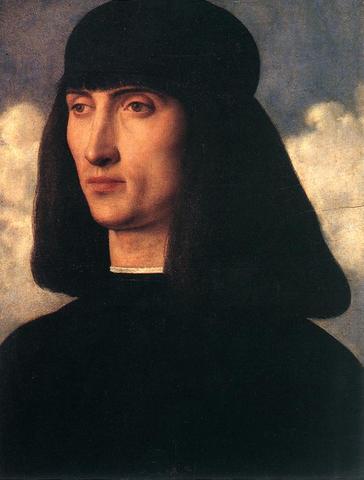
1 / 7
Portrait of a young man. Painting by Agnolo Bronzino. 1530s © Metropolitan Museum of Art
2 / 7
Portrait of Emperor Charles V. Painting by Titian. 1548 © Alte Pinakothek
3 / 7
Portrait of a young man. Painting by Giovanni Bellini. Around 1500 © Musée du Louvre
4 / 7
Portrait of Willem van Heythuissen. Painting by Frans Hals. 1625 © Alte Pinakothek
5 / 7
Empress Eugenie poses in a black dress and lace mantilla. Paris, 1859 © Collection of Olga Khoroshilova
6 / 7
Singer Paulina Lucca in a black business dress with black charcoal beads and a cross at the collar. Berlin, 2nd half of the 1860s © Collection of Olga Khoroshilova
7 / 7
An aristocrat in a black walking dress with many flounces in the Spanish style. Paris, mid-1860s © Collection of Olga Khoroshilova
